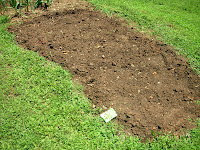



In a sustainable ecology all waste must be used productively in another way. Here in Pasadena many streets have the camphor as the assigned tree for planting by the city in the meridian. Camphor trees are tall, broad-leaf and, surprisingly, evergreen and therefore always provide shade. Nice! This is achieved every spring as the new leaves sprout and push out last years leaves. In the bottom right picture you might be able to make out the slightly tan leaves in the canopies of the trees. Those are the leaves that have yet to fall. The light green leaves are the new ones. The gutter of the street shown to the right is evidence of the leaves that have fallen so far that week. Everyone rakes these leaves up and fills their huge green waste bins each week for 3 to 4 weeks every spring. The city then hauls them off as yard waste. I do believe they dump them in an area for composting though.
Now camphor is aromatic and the leaves contain this oil. If one mulches with these freshly fallen leaves growth underneath is inhibited. So this is good mulch to reduce weed growth on paths around the garden. However, given the volume of material produced just on my short block, I had to find a way to use them. Our Calif. Dept. of Agriculture Extension Agent says that we should use 4" of mulch throughout the vegetable garden to only have to water once every 3 weeks. Since this is an urban environment, it's no easy task to come up with a regular source of so much mulch volume without a truck or a business arrangement. Therefore I am motivated to explore constructive use of this mass of organic material that literally falls in my lap like clockwork every spring.
So, my plan is to rotate leaf harvests for 3 years before deploying in the garden. Our house lot is small and one side of the house has only a narrow space between our house and the neighbor's driveway. We grow
eugenia hedges on that side leaving about 2.5' between the house and the hedge. The hedges have grown here for a few decades so the roots are deep and would be unaffected by surface deployment of camphor leaves. However, suppressing grass and other weeds in this space is a benefit. It's not easily mowed or maintained. And grass seeds are definitely not wanted in the veggie garden.
The top picture, though not very good, is where I've put the fresh harvest of leaves this year. The fourth picture is where I've spread out last year's leaves up to the trunk of the crape myrtle. The third year is to the north of the tree up to the black cat... He's not always there though. Then in the fourth year it should be safe to use the leaves as mulch. I may be overdoing it. But I can assure you there are so many leaves it's worth figuring something out to use them and it's good exercise to rake and move the material around.





























